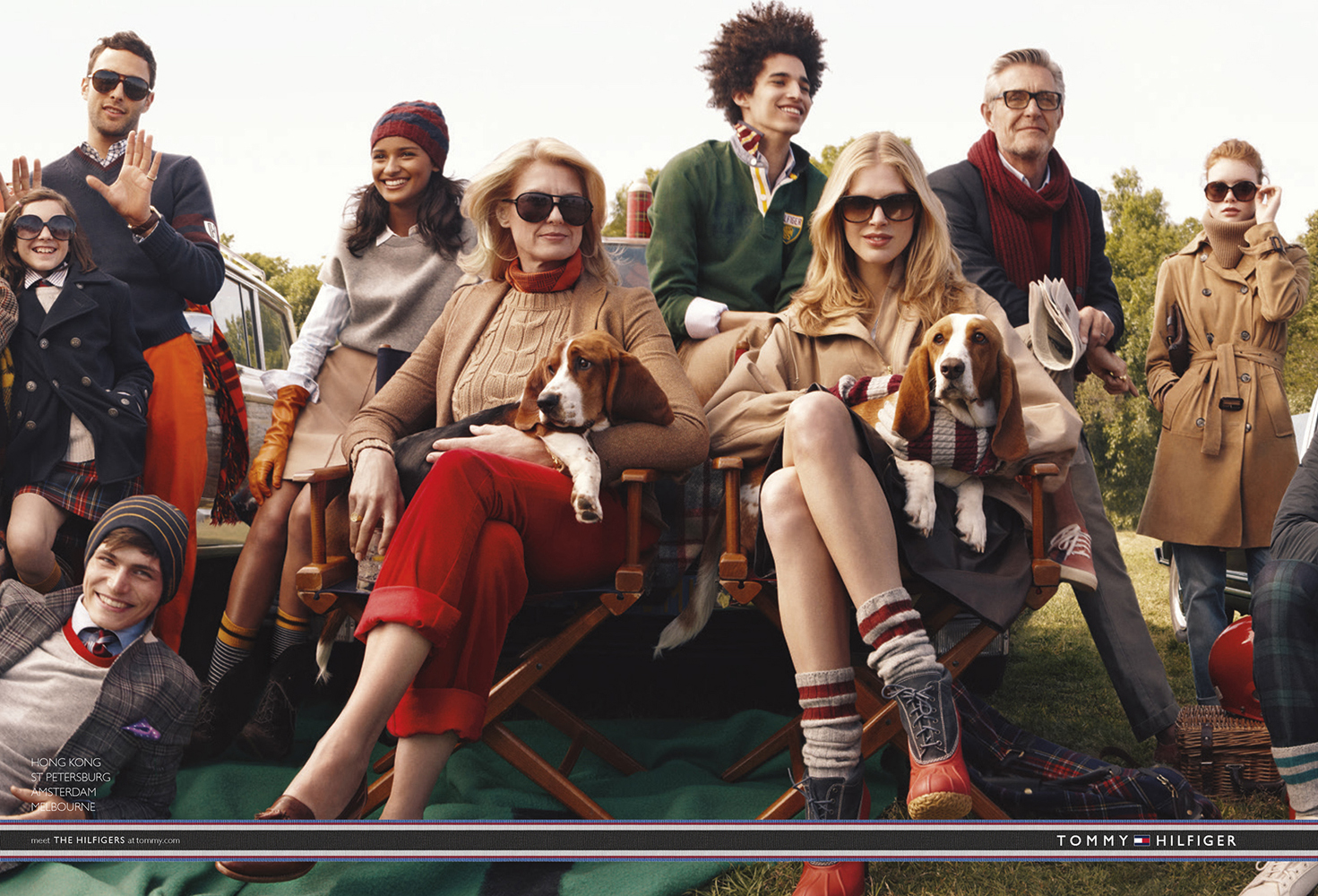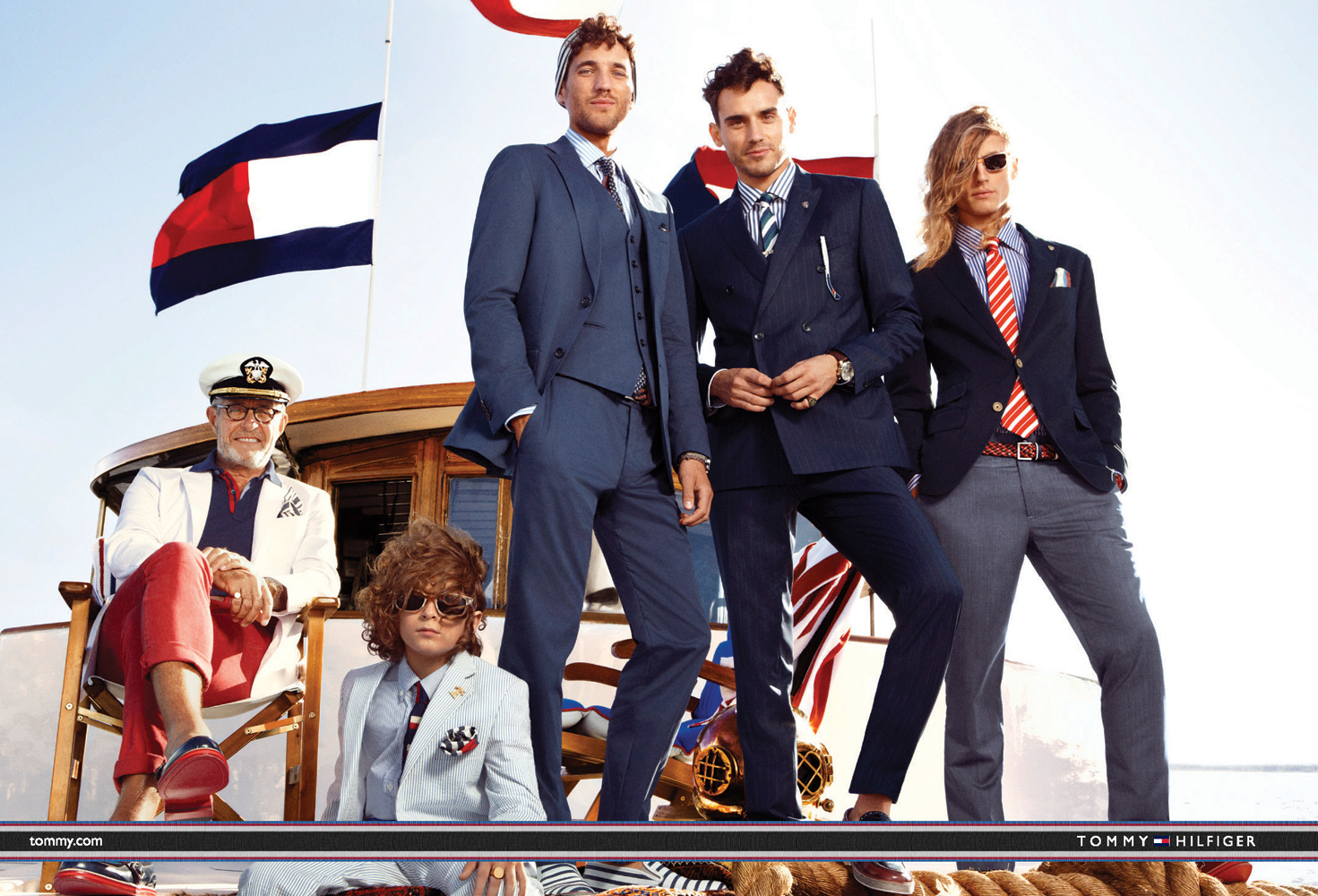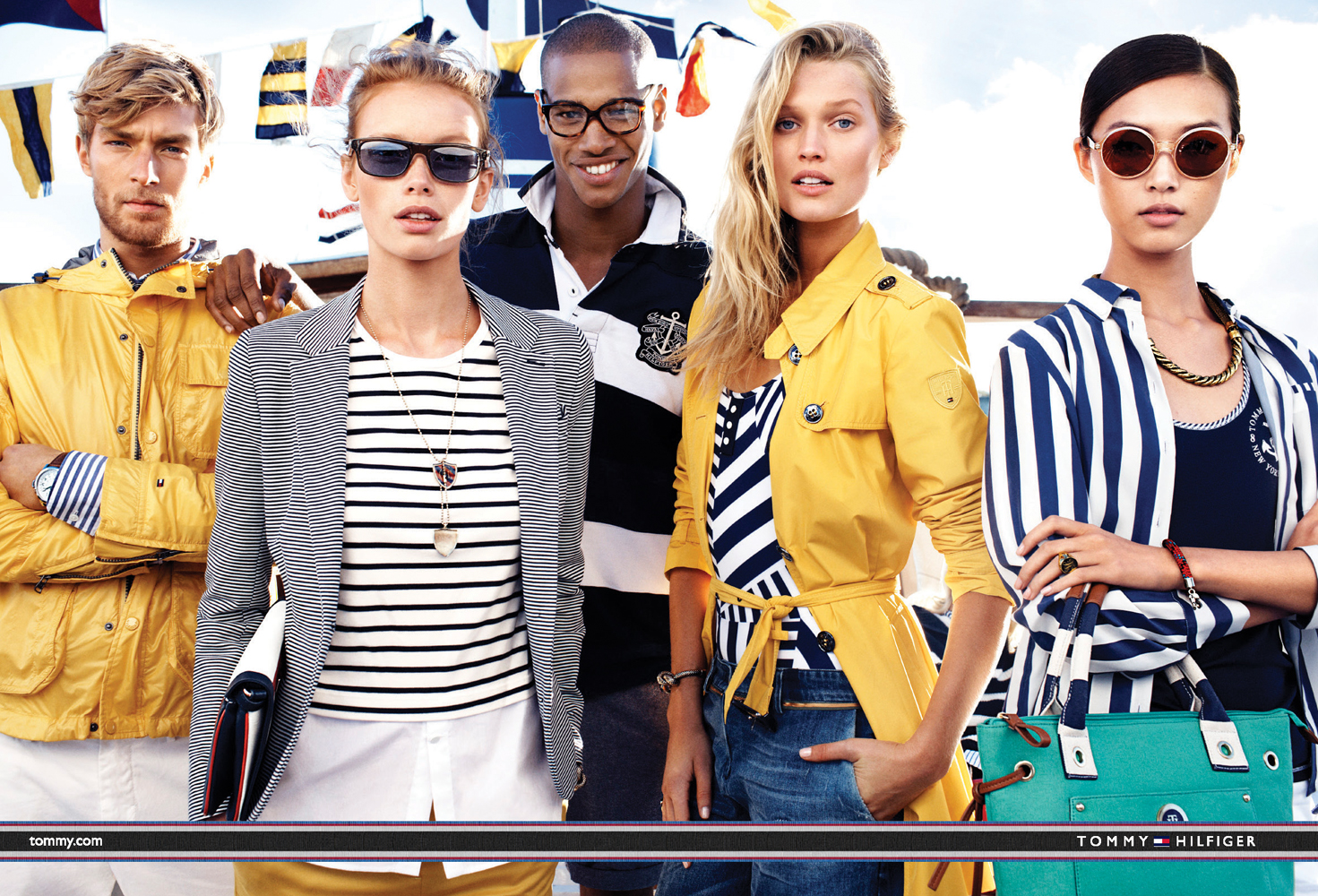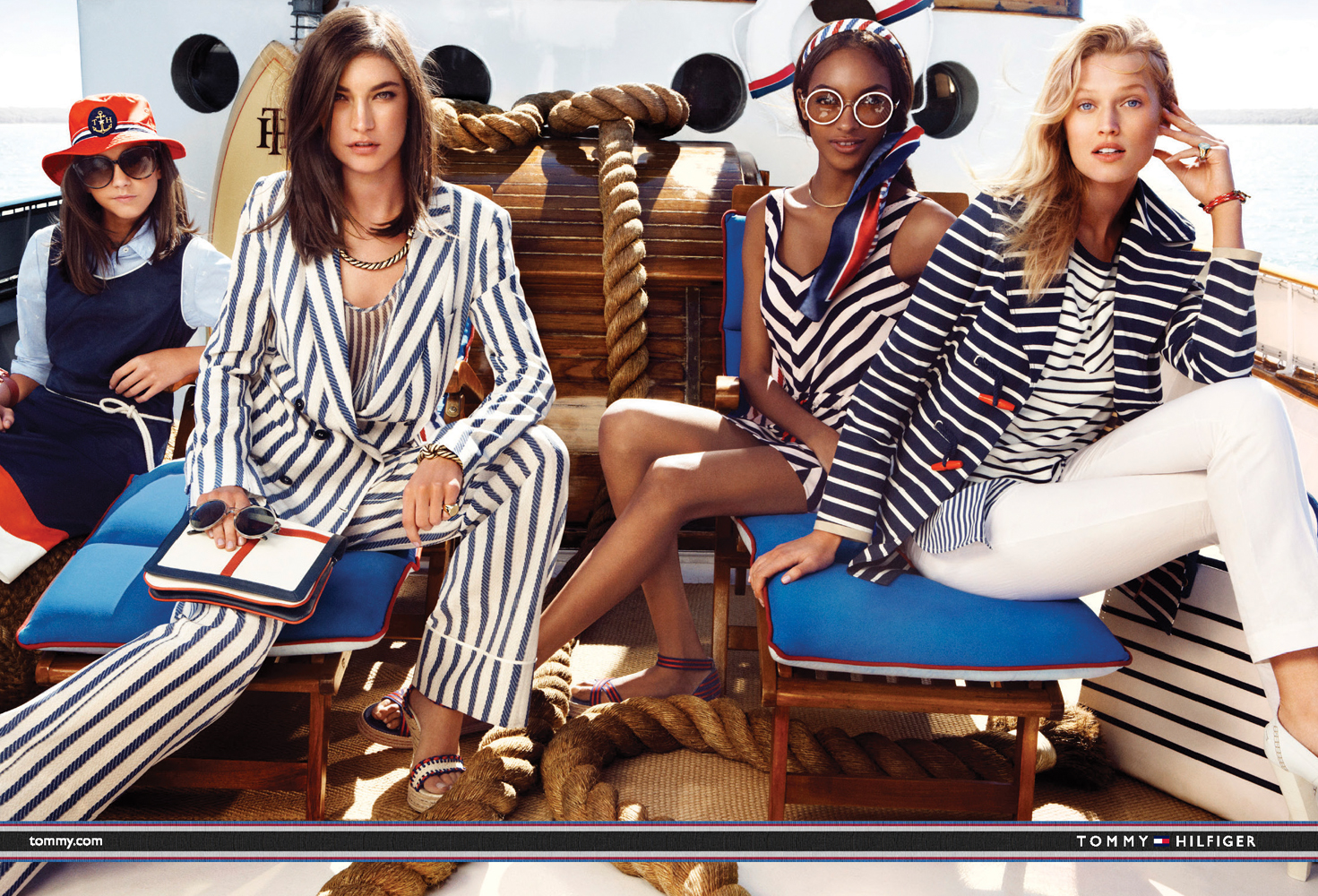For over five years The Hilfigers have enticed and entertained with their eccentric appeal. The campaign trailblazed a new path in fashion storytelling has become the longest standing ad campaign in fashion history. We spoke with the family’s creators, Trey Laird of Laird+Partners and Tommy Hilfiger Chief Marketing and Brand Officer, Avery Baker, about who the family came to be.
BY KENNETH RICHARD
Have to hand it to you two as I was looking at the archive holistically. You’ve managed to create something cohesive, offbeat, and still fresh. Dying to learn how it all came about. So, let’s talk Tommy.
Trey: It’s been 5 years, and it’s funny, when I was preparing this for you, I hadn’t seen it myself altogether in a while. And my first reaction, I was exhausted, it’s so much stuff! But it was really amazing to see the consistency. We didn’t start out thinking of it as a long, multiyear campaign, although we knew it needed to be something that was beyond a season.
We just went into it trying to come up with a way to capture the tone and the spirit of what Tommy’s all about. It’s obviously rooted in a world of classicism, but with a sort of twist. Tommy always said, “I like classics with a twist.” I think he was one of the people who coined that phrase which now everybody says. Everything in Ralph’s world was always sort of polished and kind of serious and beautiful and elegant, but Tommy’s is that same sort of classic world with a little bit more of a rebel attitude and kind of a fun spirit and inclusiveness.
We wanted to come up with something that could be a complete world and involve storytelling. Storytelling in advertising is so important and is rarely done the right way. So with this idea of a family, I really looked at Tommy’s family and Tommy has a super eclectic family. Between his kids, his wife’s kids, one son has tattoos and green hair, another one is super conservative, there’s all different ages, then you have these big, rambling houses. So it was not necessarily literally inspired by Tommy’s family, but there was something about that, this sort of inclusiveness and openness and there were always these sort of adventures that went on, that definitely figured into the initial idea.
And then obviously it goes without saying that it was certainly heavily inspired by Wes Anderson’s world. The Royal Tenenbaums was obviously one of my greatest loves and it’s got that sort of eccentricity.
And it’s still going. Gucci, obviously.
Trey: I know. So it’s kind of come back around. And obviously so much of fashion is inspired by films. In this case, it was just more the vibe and the idea of creating a group of characters that could allow you to tell stories over time, and they could go on different adventures, and different people could go in and out.

How did you two find each other?
Trey: It’s funny, I had known Tommy a long time, we had always wanted to work together but when I was doing Gap, we just never could. Then, Anna Wintour suggested Tommy and I meet again to talk about his brand. So, when I wrapped up the Gap, Tommy was one of the first people who called me and he said, “Are you ready? Let’s go!”
So Fred Gehring, who was the CEO at the time, and Avery asked us to come in and really spend a good 4 months just thinking about the brand, working on the brand, thinking about the positioning, trying to get their voice back, finding an ownable look and feel and strategy.
Avery, 4 months?
Avery: It was a different approach even for us, one we had not taken before.
Our main objective was to look at the way the brand was being articulated with fresh eyes, not just from the point of view of the advertising campaign. We were at a point where we felt we needed to breathe fresh life and energy into the way we were presenting ourselves and consumers were experiencing us – from the store to the website to the brand campaign. This was particularly in Europe, where, at that time, the brand had reached an established maturity level.
The company had been doing work on the campaign in-house for a few years prior to that and separately Trey and I had been talking to each other on and off over the years about partnering. Sometimes it didn’t work for him, and sometimes it didn’t work for us, and then we had this moment where the timing was right. I suggested he and his top people come and have kind of a full immersion into the Tommy world.
They came over and spent a lot of time in our base in Amsterdam, because at that time a lot of the business was being driven there. I was their guide, sharing, along the way, my own feelings about where the company wanted to go. It was probably the most in-depth immersion any agency could ever receive.
Trey: It was a great opportunity because sometimes when I start working with a client, they’ll immediately just want to dive into a campaign or immediately start working on execution and Fred and Avery were really smart about saying, “No, we want you to come into our world, get to know the company, get to know who we are and help us figure out what’s our road map going forward.” And to give us that time to be able to do that was amazing.
Tommy’s culture is very inclusive, too. Being based in Amsterdam, it’s super global, it’s super eclectic, every meeting you go in, there will be someone from Japan, someone from Belgium, someone from the States and someone from Italy. That really struck me, and also just trying to reclaim the sense of bringing the twist alive within a classic preppy DNA and how could we do that.
Avery: I think that is a big reason why the outcome has been so effective and strong. We brought them in and discussed and debated everything from all angles, and asked them to come back with their point of view on how we could really sharpen what Tommy Hilfiger means. It wasn’t just a concept for an ad campaign, it was a holistic view of “here’s our impression of the brand and some ideas on where we think you are underutilizing your great heritage and brand potential.”
That was fantastic dialogue and the results of that work informed the overall brand’s positioning that we then set out to deliver upon; and The Hilfigers came from that.
Trey: So we did this big brand book and worked on all different things there, because the brand had kind of lost its way and were having a hard time recovering in certain parts of the world from that.
When Tommy started, it was this lighthearted, fun, twisted take
on classic preppy. And it had kind of lost a lot of that. He was like the Prince Harry of that world –
[quote text_size=”small” author=”Trey Laird – CEO & Chief Creative Director | Laird+Partners”]
If Ralph is Prince William, I always think of Tommy as Prince Harry. He’s the wild one who stayed up all night and maybe had one drink too many, but was a lot of fun and you want to hang out with.
We wanted Tommy to reclaim that prep classicism, but with a real eccentric dose of style. The market had gotten too watered down, and there are lots of brands that do a clean-cut looking guy on the beach or in a Hamptons house with a pretty girl and that’s super boring. It’s so safe and so banal, you just want to throw up. So I didn’t want to do anything like that.
That’s how I started working with Tommy. Tommy said he wanted me to have a clean slate, close my eyes and do something that could be impactful, he didn’t want to do just a typical, safe, nice studio something. So he gave me that leeway.
Is that when The Hilfigers were born?
Trey: That’s kind of where we started, and then we just started building these characters.
Avery: The concept was very much this idea of family and an eclectic, interesting mix of people with individual personalities, perfectly imperfect. It was the next extension of everything that we had been working on, but it wasn’t until after the shoot that the idea of framing it as “The Hilfigers” came into being. That was just one of the best strokes of genius because it happened after the fact and became the glue and the magic dust that took the whole concept to the next level.
Trey: We had set out to do a family campaign, it was tailgating, we did all the casting, there was the Dad and the Mom and the dog and the kids and all that stuff. But it wasn’t until we started to do all the layouts and there was that big, packed-to-the-hilt Wagoner shot, with just every ice cooler and inappropriate piece of sports equipment and I thought, “Oh my god, this is like a cinematic thing, it needs a title and we christened it ‘The Hilfigers.’”
Then we presented to Tommy and Avery and everybody just looked at each other and was like, “Oh my god, this is definitely our campaign for the next few years.” It’s a magic moment when those things happen, because as you know, they don’t happen that often. It was one of those things I genuinely love doing. I’m really proud of it and my team loves working on it. Tommy himself has been really amazing. It comes from a place of real fun and love and excitement.
Avery: He really loved it! Tommy is an extremely open person, very transparent, loves family, and also has a great sense of humor. I think he really responded personally to this idea of a modern eclectic group of people being a bit inspired by his own modern family. I think he loves the irony of that.
Trey: With Tommy himself, it’s amazing because he’s really been one of the most trusting clients I’ve ever had. He spent a lot of time up front with me so I was clear on who he was, what his brand was all about, and he trusted us and let us do our thing. We tried not to let him down. He gives great feedback and he’s been our biggest supporter, our biggest cheerleader, he’s been such a huge help in ideas and just really all-around supportive.
So tell us about that casting.
Trey: We went through a big casting, we found Mrs. Hilfiger and she was sort of like Candice Bergen meets Martha Stewart, this kind of icy blonde with good taste, and she always has a glass of vodka. Then Mr. Hilfiger’s sort of the life of the party – we call him Silver Fox – and it just went on from there, all these characters just started playing out.
You’ve actually put one of your characters through college already, right?
Trey: Yeah, exactly, the youngest one, Chloe, who is a child prodigy. She’s amazing, and you see her grow up before your eyes, from the first season to now. We did her in Malibu, in the dune buggies with pink hair. She became kind of a rock-n-roll rebel. She’s this amazing girl.



Do the actors come to you and ask, “What’s my motivation?”
Trey: [laughs] In a way, yes. We tried to make everything very cinematic, so we definitely talked about the vibe and the attitude. We had these great moodboards and we went through them with all of the models. They really did become those people. It was sort of a merge between who they were anyway and the characters that we were inspired by. They brought so much of themselves to it and got into it.
Tell us about that first shoot.
Trey: It was really inspired by a Tailgating spread from The Preppy Handbook. When I did my presentation to Tommy – I literally brought The Preppy Handbook. What I love about it is when Lisa Birnbach first wrote that book, it was so tongue-in-cheek. It was never meant to be taken seriously, although she was talking about types of people that did take themselves seriously. And I thought there was something very Tommy about that whole approach, the kind of lightheartedness and humor.
We wanted to bring this to life, not in just a funny way, but with a touch of quirkiness and fashion sophistication too. That’s why I wanted somebody like Craig McDean to do it, because in the wrong hands, it could go too kitschy or too quirky or too funny. It needed to have chicness and a sense of style and fashion relevance. That was a tricky line to navigate.
Karl Templer has also obviously been a huge partner. He has such a great sensibility and does these incredibly researched moodboards. He approaches styling in a cinematic, storytelling way. But then at the same time, he keeps it in a fashion language so it never goes costumey. The characters always have their attitude and their look and feel. Mrs. Hilfiger always has her sunglasses on, she never takes them off. Chloe, too, never takes off her sunglasses and she always has a barrette. So there are touches like that. Karl’s such a brilliant conceptualist and not just a stylist, a genius creative director in his own right.
I think we hit on a good balance from Day 1.
When did you know you had a hit?
Trey: On the first shoot. I knew it was going to be something really special. I hadn’t done anything like that before and I knew there were endless story opportunities.
Avery: We knew the minute when we were on set and shooting with Craig that first season and just looking at the images on the screen. I already knew that we were telling a story at a different level than what the brand had done in a long time. And I think the second moment that I knew was when Trey came in with the images laid out with “The Hilfigers” as the frame and the graphic treatment and the way of telling the story – that’s when it was a complete no-brainer. Those moments happen so rarely in one’s career of trying to develop meaningful, creative work, it was very exciting.
How did you activate that?
Avery: That was another moment where you look back and realize that things just come together in a special way sometimes. We had shot the first campaign and at the same time I started speaking with Lisa Birnbach about getting behind her new book. We really hit it off and it became a much bigger conversation about how she could work with us to curate this idea of global prep as seen through the eyes of Tommy.
My team developed a fantastic concept of having this authentic, Nantucket preppy house travel as a pop-up shop around the globe with Lisa and a capsule collection inspired by this kind of twisted, preppy world. We launched simultaneous with The Hilfigers campaign so it added an incredible storytelling dimension and we were able to use some of the real Hilfigers from the ad campaign for gorilla marketing activities.
They went to the US Open and ended up on the national news in the US. We did appearances with them in similar ways in different markets around the world. This was the early days of people talking about 360 campaigns, now that’s par for the course. I think what made the whole thing so effective in terms of changing consumer perception was because it touched so many areas and was so much more than just the print campaign.
You sparked a run on Waggoners, right?
Avery: (Laughs) Exactly. Waggoners and Beagles.
What have you learned from this experience?
Trey: To have a consistent voice and stick with it in an industry that is so much about “on to the next, on to the next, on to the next.” And to figure out how to develop a consistency but at the same time, keep evolving it and pushing it. It has been a real learning experience about the value and rarity of that. You cover all these campaigns, you know how few campaigns have any sort of longevity. But at the same time, we’re in a business that is about newness so you’ve got to always serve up something fresh. So there’s been a real learning curve to figure out how to walk that line and try our best to keep it fresh and keep coming up with these stories. But then at the same time, give a brand a look that is ownable and recognizable. It takes customers a lot longer to get tired of something than press, or an editor, or somebody in the industry.
Avery: How important it is for a brand to find its unique point of difference and bring it to everything that you do. Tommy Hilfiger has such a unique set of values that are not the norm in the fashion industry – optimism, not taking things too seriously, inclusiveness, camaraderie. This campaign has been so successful because these are things people in every country, from every background, relate and aspire to. Finding that sweet spot and owning it, unabashedly, has really set us apart from the competition. And we’ve had a great time doing it!
It seems that you’ve built both a family in front of as well as behind the scenes, collaborating for longer than any other campaign and crew that I know of in fashion. Do you know of anybody else?
Avery: I don’t. I think that’s why it’s been a great relationship between myself, Trey and our teams. I’ve learned the more you put in, the more you get out with your key partners, which on this includes Karl Templer and Craig McDean as well.
[quote text_size=”small” author=”Avery Baker – Tommy Hilfiger Chief Marketing and Brand Officer”]
When you find people that are really invested in, and on board with where you want to go, then you have to trust them and let them bring their expertise to the table. There is something to be said for that type of quite intense collaboration. To me it’s been the most rewarding and valuable part of this process.
Trey: All of us, not just the models – but Craig, Karl, Avery, Tommy, the guys in props, our whole team, we all became a family. We’ve done ten of these now for five years and it’s a well-oiled machine. It’s been amazing to have that camaraderie and that longevity in a world that usually changes every season.
[hr align=”center” style=”striped”]
















